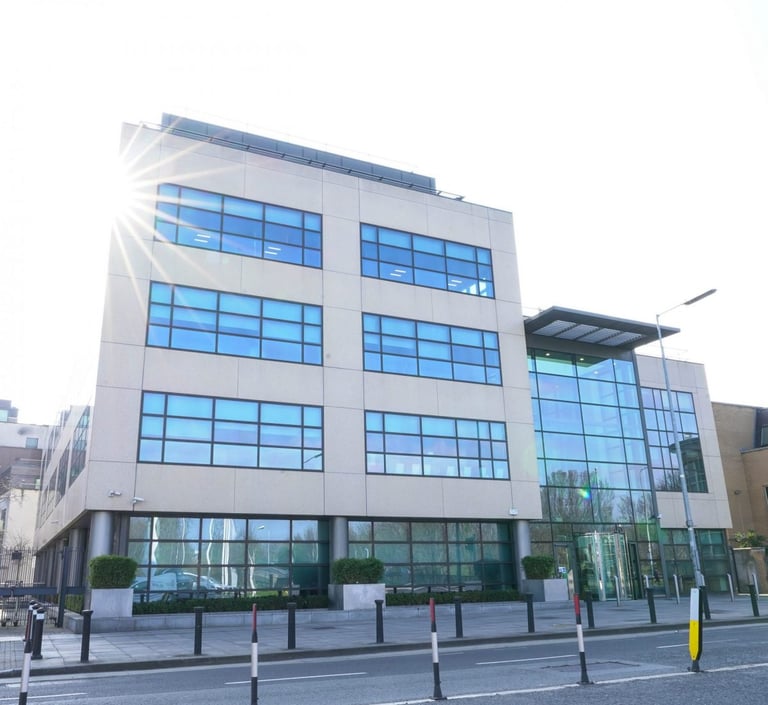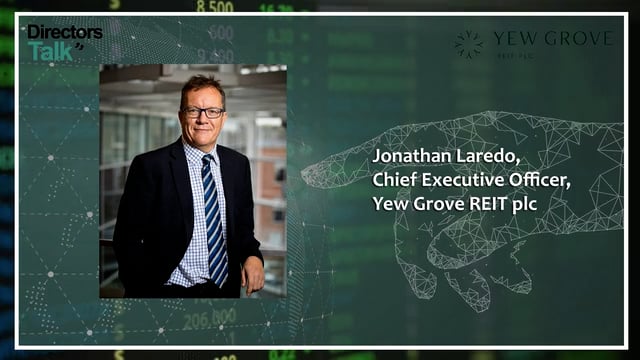Yew Grove REIT plc (LON:YEW) is the topic of conversation when Hardman and Co’s Analyst Mike Foster caught up with DirectorsTalk for an exclusive interview.
Q1: Mike, Yew Grove REIT, what do they invest in as a REIT?
A1: REIT obviously is a real estate investment trust and they specifically invest in Irish real estate and the policy, which is pretty consistent, is that there’s a balance between the regions and Dublin, but Dublin is outside the CBD. There’s also a weighting towards offices which at the moment a bit over two thirds, about 70% of the total, and there’s also a strong weighting to multinational or government, which is 95% plus.
So, it’s strong covenants on higher yielding Irish real estate.
Q2: So, the office sector dominates but are offices not sitting empty at the moment?
A2: Good point. No is the answer, their assets they’ve got within the offices around about a bit under 10% are void but most of those voids are voids that they have acquired because they are relatively young REIT that have been expanding. They’ve made acquisitions which have included void assets because you tend to get better quality assets or better pricing by doing that. They have actually filled some of those voids over the past six months.
Nonetheless, the bigger question is what about the role of offices in the future? Well, the rents on these modern offices are half or less of what they are in Dublin CBD and there is a lower ratio of desks to floor area. There also is good access because they tend to be, as I say, either regional or in the Dublin suburbs around the ring road so there’s good access for various modes of transport. There also low rise, virtually all of these office assets are three or four storeys.
So, it is very appropriate for the sort of properties where tenants might have a small amount of higher density offices in the centre of the city but switching more and more to the lower density and lower value, lower cost to the tenant offices to run for the future.
We have seen no evidence of lack of demand, as I say, there’s been floor space let and I would have thought that this low rise, lower density is exactly the sort of area that is going to be sustainable in the long-term. Further to which, the Irish economy has seen, and including in 2020, undiminished foreign direct investment coming in and, as I say, a lot of these tenants are multinational.
Q3: Are there other risks involved?
A3: If we sort of go through it fairly rapidly on some details.
The lease term is 8.1 years so it’s fairly long, but it is 4 years to break, however, although that seems maybe a little bit short, if you look at the industrial sector, which is a bit under a third, most of those tenants have been there a long time and most of those are Meditech. So, it’s not all clean rooms but there is quite an element of very high specification and the fit-out in a lot of these industrial assets is higher than the rental cost.
So, there is some risk obviously but they have invested in the fit-out and their quality and typically growing firms on the industrial.
On the office side, I think we’ve talked a little bit and we can talk more perhaps another time about the broader risks on offices but in terms of where the market is going, rents in 2019 did increase slightly more in the areas that YEW is in i.e., the Dublin suburbs versus the central business district both rental markets were pretty strong.
In 2020, there’s been no material increase in voids, obviously the proof of the pudding will be 2021 but I think we’ve talked about the underlying points before.
In terms of loan to value, it’s a fairly low level, it’s below 30%, they are looking to increase it. So, within very low risk parameters they are seeking a little bit more debt but the position they’re at now and the position they went into the pandemic was of a modest gearing on the balance sheet.
Q4: How come the company doesn’t invest in the central areas of Dublin?
A4: The yields to acquire assets in the central business district, Dublin, are about 4.5%, the yields for modern high quality assets in the areas that the company invests are affected by their office yields which are 7.5% or 8.2%, if they were to fill all the voids, as I said, there’s a little bit of void in their portfolio.
So, they’re cheaper but that isn’t necessarily the rationale. I think we’ve about the rationale that it’s better value for the occupiers and the occupiers are perhaps going to be going more onto the hub spoke model i.e., a small amount of offices in the more expensive central regions of cities and more on the lower value.
That is the main reason why they’ve avoided central business district, in a nutshell, a lot of other investors have gone for central business district, bid up the prices and the rents are quite high.
Q5: Just talking of models, what kind of returns has the model achieved so far?
A5: This year, it’s quite interesting actually because they reported first half figures for 2020 and the capital values declined by 0, they are absolutely unchanged, about £10,000 down in valuation.
That’s what the valuers say, nonetheless, that is backed up by evidence in the rental market so the returns in 2020 are looking as if the capital should be pretty secure and the yields that Yew Grove REIT are getting are north of 7%. If you look at 2019, the like-for-like values rose by 5.3% and, as I say, you’ve got the very good running yield.
It’s a slightly small REIT at the moment, they are seeking to expand but although that means that they’re less efficient than they would be if they were much bigger, you still had an overall investment return of usefully over 7% in 2019. It’s looking to be fairly similar actually in 2020 which is a bit of a standout result.










































